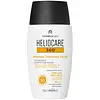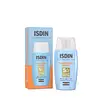What's inside
What's inside
 Key Ingredients
Key Ingredients

 Benefits
Benefits

 Concerns
Concerns

 Ingredients Side-by-side
Ingredients Side-by-side

Water
Skin ConditioningDimethicone
EmollientIsododecane
EmollientC12-15 Alkyl Benzoate
AntimicrobialHydrogenated Polydecene
EmollientTitanium Dioxide
Cosmetic ColorantZinc Oxide
Cosmetic ColorantButyloctyl Salicylate
Skin ConditioningAlumina
AbrasiveStyrene/Acrylates Copolymer
Phenethyl Benzoate
EmollientPEG-9 Polydimethylsiloxyethyl Dimethicone
EmulsifyingNylon-12
Polypodium Leucotomos Leaf Extract
Skin ProtectingFerulic Acid
AntimicrobialCaffeic Acid
AntioxidantPhysalis Angulata Extract
Skin ProtectingCaprylyl Glycol
EmollientMelanin
Skin ProtectingCamellia Sinensis Extract
AntioxidantPlankton Extract
Skin Conditioning3-O-Ethyl Ascorbic Acid
Skin ConditioningIsohexadecane
EmollientHydrogen Dimethicone
Phenylpropanol
MaskingPolyhydroxystearic Acid
EmulsifyingMagnesium Sulfate
Tocopheryl Acetate
AntioxidantDimethicone/PEG-10/15 Crosspolymer
Propanediol
SolventTriethoxycaprylylsilane
Propylene Carbonate
SolventCaprylic/Capric Triglyceride
MaskingPanthenyl Triacetate
Butylene Glycol
HumectantPropylene Glycol
HumectantArginine
MaskingEthyl Linoleate
EmollientOleyl Alcohol
EmollientPentylene Glycol
Skin ConditioningOxothiazolidine
Skin ProtectingDipropylene Glycol
HumectantSodium Citrate
BufferingPalmitoyl Hydroxypropyltrimonium Amylopectin/Glycerin Crosspolymer
Skin Conditioning1,2-Hexanediol
Skin ConditioningLecithin
EmollientSodium Benzoate
MaskingTocopherol
AntioxidantHydrogenated Lecithin
EmulsifyingPhenoxyethanol
PreservativeCI 77492
Cosmetic ColorantCI 77491
Cosmetic ColorantCI 77499
Cosmetic ColorantWater, Dimethicone, Isododecane, C12-15 Alkyl Benzoate, Hydrogenated Polydecene, Titanium Dioxide, Zinc Oxide, Butyloctyl Salicylate, Alumina, Styrene/Acrylates Copolymer, Phenethyl Benzoate, PEG-9 Polydimethylsiloxyethyl Dimethicone, Nylon-12, Polypodium Leucotomos Leaf Extract, Ferulic Acid, Caffeic Acid, Physalis Angulata Extract, Caprylyl Glycol, Melanin, Camellia Sinensis Extract, Plankton Extract, 3-O-Ethyl Ascorbic Acid, Isohexadecane, Hydrogen Dimethicone, Phenylpropanol, Polyhydroxystearic Acid, Magnesium Sulfate, Tocopheryl Acetate, Dimethicone/PEG-10/15 Crosspolymer, Propanediol, Triethoxycaprylylsilane, Propylene Carbonate, Caprylic/Capric Triglyceride, Panthenyl Triacetate, Butylene Glycol, Propylene Glycol, Arginine, Ethyl Linoleate, Oleyl Alcohol, Pentylene Glycol, Oxothiazolidine, Dipropylene Glycol, Sodium Citrate, Palmitoyl Hydroxypropyltrimonium Amylopectin/Glycerin Crosspolymer, 1,2-Hexanediol, Lecithin, Sodium Benzoate, Tocopherol, Hydrogenated Lecithin, Phenoxyethanol, CI 77492, CI 77491, CI 77499
Water
Skin ConditioningDibutyl Adipate
EmollientPropanediol
SolventEthylhexyl Salicylate
UV AbsorberEthylhexyl Triazone
UV AbsorberBis-Ethylhexyloxyphenol Methoxyphenyl Triazine
Skin ConditioningDimethicone
EmollientButyl Methoxydibenzoylmethane
UV AbsorberPhenylbenzimidazole Sulfonic Acid
UV AbsorberSilica
AbrasiveDiisopropyl Sebacate
EmollientArginine
MaskingPentylene Glycol
Skin ConditioningHydroxyacetophenone
AntioxidantLauryl PEG/PPG-18/18 Methicone
Skin ConditioningVp/Eicosene Copolymer
Polysorbate 60
EmulsifyingDimethicone/Vinyl Dimethicone Crosspolymer
Skin ConditioningGlycerin
HumectantCaprylyl Glycol
EmollientHydrated Silica
AbrasiveTocopheryl Acetate
AntioxidantPEG-10 Dimethicone
Skin ConditioningTetrasodium Glutamate Diacetate
Parfum
MaskingSclerotium Gum
Emulsion StabilisingSodium Hyaluronate
HumectantPorphyridium Cruentum Extract
Skin ConditioningXanthan Gum
EmulsifyingCitric Acid
BufferingWater, Dibutyl Adipate, Propanediol, Ethylhexyl Salicylate, Ethylhexyl Triazone, Bis-Ethylhexyloxyphenol Methoxyphenyl Triazine, Dimethicone, Butyl Methoxydibenzoylmethane, Phenylbenzimidazole Sulfonic Acid, Silica, Diisopropyl Sebacate, Arginine, Pentylene Glycol, Hydroxyacetophenone, Lauryl PEG/PPG-18/18 Methicone, Vp/Eicosene Copolymer, Polysorbate 60, Dimethicone/Vinyl Dimethicone Crosspolymer, Glycerin, Caprylyl Glycol, Hydrated Silica, Tocopheryl Acetate, PEG-10 Dimethicone, Tetrasodium Glutamate Diacetate, Parfum, Sclerotium Gum, Sodium Hyaluronate, Porphyridium Cruentum Extract, Xanthan Gum, Citric Acid
 Reviews
Reviews

Ingredients Explained
These ingredients are found in both products.
Ingredients higher up in an ingredient list are typically present in a larger amount.
Arginine is an amino acid that is important for human development. Your body uses is it to produce hair keratin and skin collagen.
As a cosmetic ingredient, Arginine has antioxidant properties and can also help repair damaged skin. This ingredient is derived either synthetically or from animals.
Arginine isn't fungal acne safe when used in the presence of other lipids (fats, fatty acids, oils, esters, etc). Oils and fats occur naturally within the skin, so take caution when using Arginine if you're prone to fungal acne.
Learn more about ArginineCaprylyl Glycol is a humectant and emollient, meaning it attracts and preserves moisture.
It is a common ingredient in many products, especially those designed to hydrate skin. The primary benefits are retaining moisture, skin softening, and promoting a healthy skin barrier.
Though Caprylyl Glycol is an alcohol derived from fatty acids, it is not the kind that can dry out skin.
This ingredient is also used as a preservative to extend the life of products. It has slight antimicrobial properties.
Learn more about Caprylyl GlycolDimethicone is a type of synthetic silicone created from natural materials such as quartz.
What it does:
Dimethicone comes in different viscosities:
Depending on the viscosity, dimethicone has different properties.
Ingredients lists don't always show which type is used, so we recommend reaching out to the brand if you have questions about the viscosity.
This ingredient is unlikely to cause irritation because it does not get absorbed into skin. However, people with silicone allergies should be careful about using this ingredient.
Note: Dimethicone may contribute to pilling. This is because it is not oil or water soluble, so pilling may occur when layered with products. When mixed with heavy oils in a formula, the outcome is also quite greasy.
Learn more about DimethiconePentylene glycol is typically used within a product to thicken it. It also adds a smooth, soft, and moisturizing feel to the product. It is naturally found in plants such as sugar beets.
The hydrophilic trait of Pentylene Glycol makes it a humectant. As a humectant, Pentylene Glycol helps draw moisture from the air to your skin. This can help keep your skin hydrated.
This property also makes Pentylene Glycol a great texture enhancer. It can also help thicken or stabilize a product.
Pentylene Glycol also acts as a mild preservative and helps to keep a product microbe-free.
Some people may experience mild eye and skin irritation from Pentylene Glycol. We always recommend speaking with a professional about using this ingredient in your routine.
Pentylene Glycol has a low molecular weight and is part of the 1,2-glycol family.
Learn more about Pentylene GlycolPropanediol is an all-star ingredient. It softens, hydrates, and smooths the skin.
It’s often used to:
Propanediol is not likely to cause sensitivity and considered safe to use. It is derived from corn or petroleum with a clear color and no scent.
Learn more about PropanediolTocopheryl Acetate is AKA Vitamin E. It is an antioxidant and protects your skin from free radicals. Free radicals damage the skin by breaking down collagen.
One study found using Tocopheryl Acetate with Vitamin C decreased the number of sunburned cells.
Tocopheryl Acetate is commonly found in both skincare and dietary supplements.
Learn more about Tocopheryl AcetateWater. It's the most common cosmetic ingredient of all. You'll usually see it at the top of ingredient lists, meaning that it makes up the largest part of the product.
So why is it so popular? Water most often acts as a solvent - this means that it helps dissolve other ingredients into the formulation.
You'll also recognize water as that liquid we all need to stay alive. If you see this, drink a glass of water. Stay hydrated!
Learn more about Water